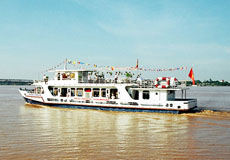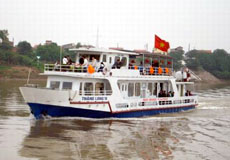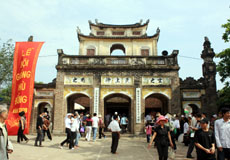The Red (Hong) River, also known Cai or Ca (Mother) river, is the birthplace of the Vietnamese civilisation - from the Hoa Binh and Dong Son cultures of 5,000 years ago and more to the founding of Co Loa, the first recorded Vietnamese capital just upstream from modern day Ha Noi.
 While an inspiring expanse of water that waters and fertilises a vast and fertile delta, the river is not as popular with locals and visitors as those in other parts of Viet Nam. This is because long stretches of the banks through Ha Noi are strewn with rubbish or covered with often unsightly illegal housing.
While an inspiring expanse of water that waters and fertilises a vast and fertile delta, the river is not as popular with locals and visitors as those in other parts of Viet Nam. This is because long stretches of the banks through Ha Noi are strewn with rubbish or covered with often unsightly illegal housing.
There are few parks or gardens along it and few paths for people to stroll along or relax, like beside the Hau river in Can Tho on the Mekong, Delta or the romantic Thu Bon and De Vong rivers in Hoi An.
However, for those interested in what can be called the soul of Ha Noi, river tours have opened up this magnificent stretch of water still has an idyllic appearance in places.
Few tourists, or Hanoians themselves, have seen the beauty of the pagodas, villages and market gardens stretching along quiet banks of the river less than 6km away. The beauty and majesty of the Red River can now be viewed by booking a tour on one of many cruise boats. River tours are a wonderful escape from the noise and dust of Ha Noi.
Second largest
The Red River is the second largest river in Viet Nam after the Mekong. It descends from Yunnan in mountainous southwestern China. It enters Viet Nam near the Lao Cai border and curves through the northern plains for more than 1,000km before emptying into beautiful Ha Long Bay.
The Red River Delta is the hub of all economic activity in the north of Viet Nam and is where most of the region’s population is concentrated. Until the development of a strong road system, the Red River was the main route transporting cargo to and from the capital.
 The Red River Tourism Investment and Development Company has created several options for Red River tours. Visitors can choose to travel upstream or downstream. In either direction, slabs of history are revealed - together with the culture and livelihoods of the rural and urban people.
The Red River Tourism Investment and Development Company has created several options for Red River tours. Visitors can choose to travel upstream or downstream. In either direction, slabs of history are revealed - together with the culture and livelihoods of the rural and urban people.
The boat on the upstream route makes fewer stops, but the landscape along the way is more picturesque. Cruises normally start at about 7.30am as the mist is still clearing, the sunshine is mild, and the wind blowing gently - as it usually does as it is stirred by the wide, swirling waters.
Tour guides offer passengers interesting stories about Viet Nam’s history as the vessels motor by. On board, there are often displays of Vietnamese art and culture.
After one and a half hours of cruising, most tours downstream make their first stop at Dam Temple. (Temples usually are devoted to legendary heroes and heroines, while pagodas worship the Buddha.)
The origins of the temple are not clear, but it is known to have been set up to worship a princess from the water world. Legend has it that a thi tree in the temple is sacred. Standing under the tree, elderly visitors pray for good daughters and sons-in-law.
Next stop on the way is Dai Lo Temple in Dai Lo hamlet, Ninh So commune. It was built by the riverside 700 years ago. Its solid ancient architecture is oriented to the south to get fresh sea breezes.
The cruises are popular with visitors from all over Viet Nam, foreign tourists and overseas Vietnamese. Elderly Vietnamese prefer to sit on soft leather chairs on the main lounge deck of the boat, admiring the scenery on the river and its banks through glass windows.
Most younger people and foreigners prefer to climb onto the upper deck to have a broader view - and enjoy the fresh air.
Trips open with a new perspective of the capital. Travelling under the Chuong Duong and Long Bien bridges while vehicles are bustling overhead is an amazing experience.
On the left bank, newly built skyscrapers mushroom along an extensive city skyline. The mossy tiled roofs of the Old Quarter are shadowed by beautiful trees, creating a nostalgic sight for Hanoians. On the right bank are tranquil rural villages bordered by bamboo hedges and orchids.
 Another downstream destination takes two hours. The boats turns right into the Duong River and anchor at the suburban village of Phu Dong in Gia Lam district, the home village of the legendary hero Giong. He is credited with defeating the Yin enemy in the north on an iron horse and is said to have flown to heaven after the victory.
Another downstream destination takes two hours. The boats turns right into the Duong River and anchor at the suburban village of Phu Dong in Gia Lam district, the home village of the legendary hero Giong. He is credited with defeating the Yin enemy in the north on an iron horse and is said to have flown to heaven after the victory.
Giong Temple in Phu Dong is one of four temples in the area worshipping him. Next to his temple is Kien So Pagoda, where King Ly Thai To (974-1028) spent his childhood. Built in 820, it is one of the oldest Buddhist pagodas in Viet Nam.
Boats continue downstream from Phu Dong village after lunch time. On the way back, they stop at Ghenh Temple and Bo De Pagoda. A day of cruising down the river, visiting historic places and strolling through the countryside usually ends at 4.15pm.
On-board services are not luxurious, but tourists find the trips pleasant and relaxing. More information is available at website dulichsonghong.com.